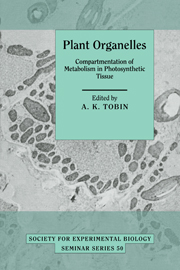Book contents
- Frontmatter
- Contents
- List of Contributors
- Preface
- Acknowledgements
- Metabolic interactions between organelles in photosynthetic tissue: a mitochondrial overview
- Metabolite transport in plant cells
- Metabolic interactions during photosynthetic and respiratory nitrogen assimilation in a green alga
- Carbon and nitrogen cycling between organdies during photorespiration
- Metabolic interactions between organelles in C4 plants
- Metabolic interactions in leaves of C3–C4 intermediate plants
- Metabolite compartmentation and transport in CAM plants
- Transport of H+, K+ and Ca2+ at the vacuolar membrane of plants
- Regulation of mitochondrial respiratory activity in photosynthetic systems
- Biosynthesis and assembly of the enzymes involved in lipid metabolism in plants
- The role of carnitine in plant cell metabolism
- Metabolic interactions of organelles in guard cells
- Transport of proteins into chloroplasts
- Metabolic interactions of organelles during leaf development
- Index
Preface
Published online by Cambridge University Press: 05 December 2011
- Frontmatter
- Contents
- List of Contributors
- Preface
- Acknowledgements
- Metabolic interactions between organelles in photosynthetic tissue: a mitochondrial overview
- Metabolite transport in plant cells
- Metabolic interactions during photosynthetic and respiratory nitrogen assimilation in a green alga
- Carbon and nitrogen cycling between organdies during photorespiration
- Metabolic interactions between organelles in C4 plants
- Metabolic interactions in leaves of C3–C4 intermediate plants
- Metabolite compartmentation and transport in CAM plants
- Transport of H+, K+ and Ca2+ at the vacuolar membrane of plants
- Regulation of mitochondrial respiratory activity in photosynthetic systems
- Biosynthesis and assembly of the enzymes involved in lipid metabolism in plants
- The role of carnitine in plant cell metabolism
- Metabolic interactions of organelles in guard cells
- Transport of proteins into chloroplasts
- Metabolic interactions of organelles during leaf development
- Index
Summary
Plant cells, like those of all eukaryotes, are divided into subcellular compartments, or ‘organelles’. This compartmentation serves a number of functions. It may concentrate a metabolite and provide a more favourable environment in which the enzymes may operate. It may separate intermediates from enzymes and, hence, avoid futile cycles or unwanted byproducts. It may also enable pathways to interact more efficiently by bringing together a number of enzymes within the same organelle. Compartmentation, however, also poses a number of potential problems. The substrate required by a mitochondrial enzyme, for example, may be manufactured in the chloroplast. There is thus a requirement for controlled and coordinated fluxes of intermediates between organelles. Similarly, most proteins are nuclear-encoded and synthesised in the cytoplasm and those localised within organelles will have to cross at least one boundary membrane. This book addresses the way in which the metabolism of photosynthetic tissue is compartmentalised between organelles and how this compartmentation leads to controlled interaction between the organelles.
In 1991, a meeting was held on the topic of ‘metabolic interactions of organelles in photosynthetic tissue’ as part of the annual meeting of the Society for Experimental Biology, at the University of Birmingham (jointly organised by the Intracellular Co-ordination Group and the Plant Metabolism Group of the SEB). Invited speakers were asked to contribute a review of their subject area and these have been collected together to produce this volume.
- Type
- Chapter
- Information
- Plant OrganellesCompartmentation of Metabolism in Photosynthetic Tissue, pp. xv - xviPublisher: Cambridge University PressPrint publication year: 1992

